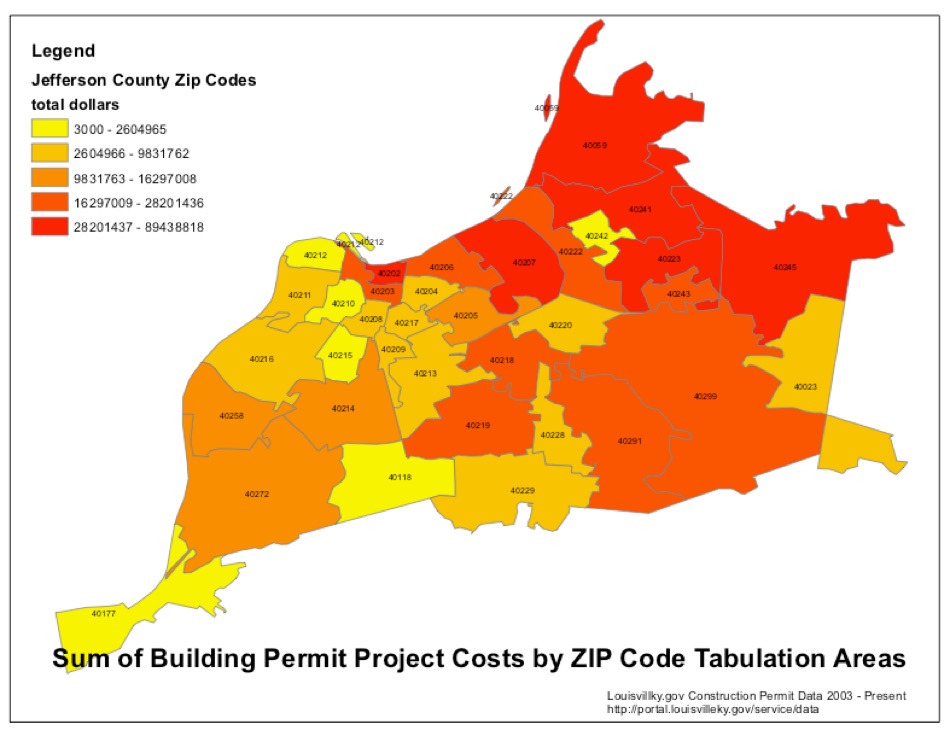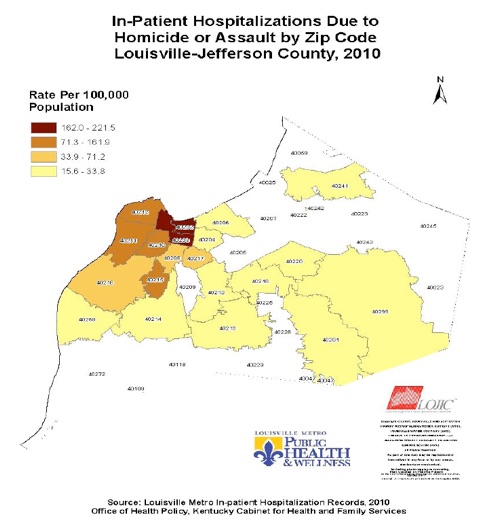CART Community Conversation opens dialogue on unequal government subsidy for east end development

EAST
Louisville economic development trending east 2003-2012
WEST
45% of the community lives in segregated enclaves,
13% of JCPS students are homeless,
median income for lowest income earners sank 5%
Cathy Hinko MHC
At the Community Conversation there seemed to be general agreement that Louisville is trapped in race and economic segregation.
There is a Metro Government policy to avoid “pointing fingers” at persons and organizations that have caused the present inequity. This is convenient to say the least. When you get robbed on the street, what would you think if the police came and said, “but don’t point your finger at anyone?”
Pointing fingers is generally how the forces that perpetuate injustice get identified. So its perplexing that Metro Government wants everyone to put on blinders as we face the issue.
It may be because the racist undercurrent of transportation and metro government planning is among the main causes of human suffering in Louisville.
It may also be because the history of racist oppression is a history of vicious programmatic backlashes at those who seek justice. Don’t underestimate the sources of social inequity.

KIPDA HERE
METRO HERE
URBAN HERE
MHC HERE
U of L HERE

Anthony Perry, 17, moves the conversation forward
On March 24, 2013, at the Muhammad Ali Center in Louisville, Kentucky, Anthony Perry moved the community conversation forward another step by organizing a conference on the School to Prison Pipeline. Perry was stunned when he saw statistical data of academic suspensions for Jefferson County schools. A school like Shawnee High School predominantly African American had 500 students but had 700 academic suspensions. White Dupont Manual with 1200 or so students mostly white, had only 24 suspensions.
These statistics made Anthony want to dig deeper to find the causes and how it could be changed. He hosted the conference at the Center and presented his concerns and introduced four speakers including, former prosecutor
Hon. Joe Gutmann, now a teacher at Central High School’s Law magnet program.
Dr. Judi Vanderhaar, presented her informative statistical analysis correlating likelihood of suspensions with factors of poverty, special needs and homelessness.
Dr. Kathleen Spencer Cooter spoke passionately about helping the youngest children in need to learn sociability skills at an early age to reduce rates of suspension.
Cooter exploded some myths about black males and higher education showing that their enrollment in college was 5% total college enrollment which matches their 5% of the total population.
Perry played a video interview with Michelle Alexander, celebrated author of the book, The New Jim Crow. Alexander was honored by a portrait that will hang in the Ali Center. See New JIM Crow on the Books page HERE


Perry has a number of active projects and an impressive list of accomplishments including being on the youth advisory board of the Tavis Smiley Foundation. With so much acclaim at an early age he will have to pay attention to keep from being co-opted into causes and organizations that would like to borrow his celebrity without having to do the hard work these social justice issues will require. As Perry said at the conference, the numbers show somethings not right, and getting to the bottom of it, will be a deeper dive than many are prepared to take.
Below: young members of the ‘Boys to Men’ training group
Louisville is not the only or first city where post World War Two
suburban development “white flight” led to an impoverished black urban core surrounded by affluent white suburbs.
In the past decade millions of dollars have been spent sending major sewer trunk lines out to the suburbs to serve out ring development. Available urban core properties to support new business and residential development were neglected and abandoned leaving poor people trapped in poverty and joblessness.
This story --the Detroit version was first told in 1966 by Thomas Sugrue.

“blame the schools, but indict the society”
The school system is shown to reflect the segregated larger community in Jefferson County Kentucky. Poverty and minority populations are grouped in the western half of the county, the white affluent populations is grouped in the eastern county, and the pattern of academic achievement, graduation rates and academic discipline rates follow the same divisions.
At the conference Dr. Vanderhaar showed slides of the number of children in the JCPS free lunch program and that are homeless.
FORD Motor Company earned $ 1.2 billion in the 4th Quarter 2012. UPS revenue increased 2.3 percent annually to a record $14.57 billion. Humana 4Q12 consolidated revenues were $9.56 billion. GE announced fourth-quarter 2012 operating earnings of $4.7 billion
In Metro Louisville, in the 2011-2012 school year 12,389 students were homeless. This number has increased year after year since 2004 when 4,898 were homeless. 68 % of the students in elementary were part of free or subsidized lunch program. The larger societies priorities of inequitable millions for CEOs and poverty for low wage earners produces misery that touches many lives. When you see a Fortune 500 CEO think of a homeless child in Louisville. Louisville’s segregated society is a product of decision makers at the top of the heap, and is no accidental circumstance.
Metro Housing Coalition

JCPS Discipline Referrals for Aggression – School Year 2011-12
JCPS’ 2011-12 Discipline Referrals for Aggression total 8,321.
This number represents the total number of incidents for aggressive events resulting in a referral and represent 5,566 unique/unduplicated students. Cited events include: 1st- 4th degree assault; fighting, carrying/using a dangerous instrument; robbery; sexual assault and possession of a firearm.
• 4,631 of the events occurred in middle schools
• 1,999 happened in high schools
• 1,691 took place in elementary schools
Noteworthy: Referrals for ―student to student fighting or striking‖ numbered 6,748 of the total 8,321 referrals for aggression.
The majority of the events happened at the middle school level (4,070), followed by high school (1,477) and then elementary (1,201). The data changes when examining referrals for ―student fighting staff or other officials‖. Though middle-school students continue to lead on this data point with 190 referrals, elementary age students accumulated more referrals than high school students with 289 and 112, respectively.
African- American students in JCPS are disciplined at a significantly higher rate than white students. Although African-American students comprise 37.2% of the JCPS student population they accounted for 66.51% of the discipline referrals for aggression as compared to Whites at 27.75%.
The five most frequently occurring zip codes for students receiving discipline referrals for aggressive events during the 2011-12 school year are:
Zips Neighborhoods # Referrals
40211 Chickasaw, Parkland, Park DuValle, Shawnee 1,034
40216 Clover Leaf, PRP, Shively and St. Dennis 754
40210 Algonquin, California, Park Hill 697
40212 Portland, Russell, Shawnee 625
40203 Limerick, Old Louisville, Portland, Russell, 575
Shelby Park, Smoketown
Source: Strategies to Prevent Violence in Louisville Metro:
Short and Long-term Recommendations, Page 34
Dr. LaQuandra Nesbitt, Co-Chair Dr. J. Blaine Hudson, Co-Chair,
Violence Prevention Work Group

Based on a mapping exercise conducted as part of the JRI planning process in 2005, 48% of the individuals released from prison to supervision resided in just six local zip codes
40211 Chickasaw, Parkland, Park DuValle, Shawnee
40216 Clover Leaf, PRP, Shively and St. Dennis
40210 Algonquin, California, Park Hill
40212 Portland, Russell, Shawnee
40203 Limerick, Old Louisville, Portland, Russell
40218 Newburg
These zips contain only 22% of the general population.
Page 69